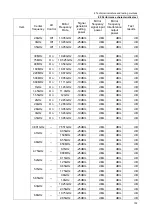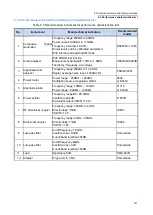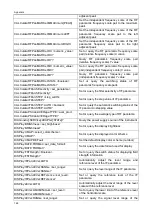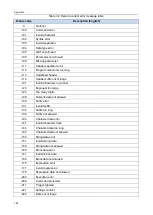
Appendix
143
Spurious response
The unexpected spurious signal on the monitoring receiver display. Spurious response consists of
spurious response and residual response, the former refers to the abnormal response occurred in the
monitoring receiver display along with the input signal, consisting of harmonic response, intermodulation
response, mirror frequency response, multiple response and out-of-band response; the spurious
response can also be divided into the harmonic response and non-harmonic response, and the later
refers to the intermodulation response and residual response. The sub-items are described below:
a) Harmonic distortion
When the input signal amplitude increases to a level to let the mixer works in the non-linear status, the
mixer will generate harmonic components of such input signal, and such components are called
harmonic distortion.
b) Mirror frequency and multiple responses
During frequency mixing, two input signals can generate the same IF signal with that of the LO signal
with the same frequency, with one signal frequency one IF lower than the LO and another signal
frequency one IF higher than the LO. In this case, one of the signal is called the mirror frequency of the
other. Each frequency of the LO has a mirror frequency of corresponding input signal, with the difference
of two IFs between the signal and the mirror frequency.
Multiple responses refer to two or multiple responses caused by the input signal with signal frequency on
the display, that is, to respond to two or multiple LO frequencies, the interval between the LO
frequencies of such multiple responses is two times of the IF. Multiple responses occur only when the
mixing mode overlaps and LO sweeps a sufficient range to make the input signal mixed in more than
one mode. monitoring receiver has different principle structure, and the frequency causing mirror and
multiple responses varies, too.
c) Residual response
It refers to the discrete response displayed when monitoring receiver is not input with any signal.
Dynamic range
The maximum power ratio between two or more signals present at the input of the monitoring receiver at
the specified accuracy, expressed in dB, characterizes the ability to measure the difference in amplitude
of two or more signals simultaneously. The dynamic range has multiple signal dynamic range, single
signal dynamic range, instantaneous dynamic range, and safe dynamic range, which has different from
the concept of displaying range and measurement range. Factors that affect dynamic range include
display average noise level, internal distortion, noise sidebands, input attenuators, logarithmic amplifiers,
detectors, and AD converters.
The optimal second- and third-order distortion-free measurement dynamic range can be calculated
based on the following formula.
2
1
)
2
MDR
SHI
DANL
(
3
2
(
)
3
MDR
TOI
DANL
Whereas:
MDR
2
—
the optimal second-order distortion-free measurement dynamic range
SHI -
second order distortion intercept point
DANL -
display average noise level
MDR
3
—
the optimal third-order distortion-free measurement dynamic range
TOI -
third order distortion intercept point
FFT
Abbreviation for Fast Fourier Transform. It performs a specific mathematical analysis of the time domain
signal and gives the results of the frequency domain analysis.
Содержание 3943B
Страница 2: ...3943B Monitoring Receiver User s Manual Ceyear Technologies Co Ltd...
Страница 4: ......
















































